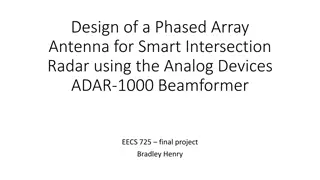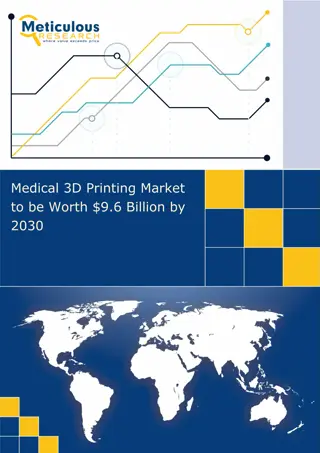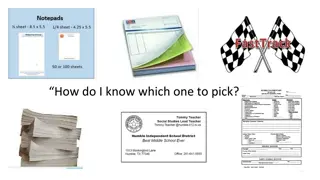Understanding the Intersection of 3D Printing and Patents in Law
Delve into the realm of 3D printing and patents through the lens of law, exploring the roles of key actors such as raw material suppliers, 3D printer machine suppliers, end-users, customers, and data file suppliers. Learn about patent infringement, exclusive rights conferred under TRIPS Article 28, and the nuances of private personal use in relation to patent laws in various jurisdictions.
Download Presentation

Please find below an Image/Link to download the presentation.
The content on the website is provided AS IS for your information and personal use only. It may not be sold, licensed, or shared on other websites without obtaining consent from the author. Download presentation by click this link. If you encounter any issues during the download, it is possible that the publisher has removed the file from their server.
E N D
Presentation Transcript
3D Printing and Patents 3D Printing and Patents Professor David C Musker Centre for Commercial Law Studies Queen Mary University of London
3D Printing 3D Printing the actors the actors 3d Printer Machine Supplier End-User of 3D Printer Customer of End-User Raw Material Supplier Internet Service Provider CAD File Supplier
Positions of the actors in patent law Positions of the actors in patent law Raw Materials Supplier is not an infringer of a product or process patent 3D Printing machine Supplier is not an infringer of a product or process patent End User Use may be non-commercial and not an infringement Use may be commercial and an infringement of a product patent Customer of End User Use may be non-commercial and not an infringement Use may be commercial and an infringement of a product patent Data File Supplier - Position depends on indirect infringement law plastics and metals with non-infringing uses non-infringing uses
Patent Infringement Patent Infringement - - Direct Direct TRIPS Article 28 - Rights Conferred 1. A patent shall confer on its owner the following exclusive rights: (a) where the subject matter of a patent is a product, to prevent third parties not having the owner s consent from the acts of: making, using, offering for sale, selling, or importing for these purposes that product; (b) where the subject matter of a patent is a process, to prevent third parties not having the owner s consent from the act of using the process, and from the acts of: using, offering for sale, selling, or importing for these purposes at least the product obtained directly by that process.
Private Personal Use outside infringement Private Personal Use outside infringement China Patent Law Article 11: may not, for production or business purposes, manufacture, use, offer to sell, sell, or import the patented products, use the patented method, or use, offer to sell, sell or import the products that are developed directly through the use of the patented method. Also Algeria, Uganda, Kenya and Madagascar, Japan, Israel, Austria, Poland, Norway, Netherlands (source: WIPO SCP/20/3)
Private Personal Use an exception Private Personal Use an exception TRIPS Article 30 Exceptions to Rights Conferred Members may provide limited exceptions to the exclusive rights conferred by a patent, provided that such exceptions do not unreasonably conflict with a normal exploitation of the patent and do not unreasonably prejudice the legitimate interests of the patent owner, taking account of the legitimate interests of third parties. Europe UPCA, Community Patent Agreement Article 27 (neither in force) The rights conferred by a patent shall not extend to any of the following: (a) acts done privately and for non-commercial purposes;
Patent Infringement Statutes Patent Infringement Statutes Indirect Indirect United States Japan EU Legislation 35 U.S.C 271(c) Article 101 of Patent Act of Japan UPCA Art 26, national law Infringing Articles Exclusive articles and non-widely distributed, non-exclusive articles Means relating to an essential element of the invention Exclusive articles Acts of infringement Offers to sell or sells, or imports Producing, assigning, etc., importing or offering for assignment, etc. Offering or supplying Not required for exclusive articles; for non-widely distributed, non-exclusive articles, knowing that the invention is a patented invention and that the articles are to be used for employing the invention Knowledge that the combination for which his component was especially designed was both patented and infringing Knowledge of or it is obvious from the circumstances that such means are suitable and intended for the use of the invention Knowledge and intent to infringe Direct Infringement is Required? Yes No No
Private end Private end- -user in indirect infringement user in indirect infringement Europe UPCA, Community Patent Agreement Article 26 (neither in force) (3) Persons performing the acts referred to in Article 27(a) to (e) shall not be considered to be parties entitled to exploit the invention within the meaning of paragraph 1.
Instructions Instructions per se per se for indirect infringement for indirect infringement US instructions per se are not an infringing component Supplying instructions together with parts may infringe Microsoft Corp. v. AT&T Corp., 550 U.S. 437 (2007) software in the abstract (not on a disc) was not a component to infringe a product claim; perhaps could only be a component if on a physical medium no infringement. But Federal Circuit may disagree - see Lucent v. Gateway, 580 F.3d 1301, 1321 (Fed. Cir. 2009) it might be material to infringe a process claim. UK/EU probably the same conclusion: Menashe v William Hill [2003] RPC 31, [2002] EWCA Civ 1702 software supplied on a disc was means infringement
Design Data files and indirect infringement Design Data files and indirect infringement Agilent Technologies v Waters Corp [2004] EWHC 2992 (Ch) device handbook instructions did not constitute means no infringement Pellegrini v. Analog Devices, Inc., 375 F.3d 1113, 1117-19 (Fed. Cir. 2004) - Defendant supplied chip designs to its foreign factories which manufactured and sold them abroad not a component to infringe a product claim no infringement summary judgment But more recently, ClearCorrect v ITC imported data files for making dental parts were a material infringement of method claims which included the data sets as an integer (on appeal, ITC held to have no jurisdiction) No high authority in any country on CAD files for a 3D printer
Other tort claims Other tort claims Variable between different countries Weaker in some countries because of displacement by Indirect Infringement patent laws In China, regulated by Article 9 of the Tort Liability Law and Article 21 of the Second Judicial Interpretation (2016) Variable application in many countries, taking into account various factors But if the end user is not an infringer, is it really a tort for others to facilitate, procure, conspire etc to produce a non-infringement? See, e.g., Limelight Networks, Inc. v. Akamai Technologies, 134 S. Ct. 2111 (2014)
Conclusions on the current state of patent law Conclusions on the current state of patent law Three new players: The home 3D printer for private, non-commercial purposes The CAD file seller The ISP Potential for impact on sales of patented products, if buyers turn into makers Globally, home 3D printer is usually a non-infringer (except in US?) The position of the CAD file seller needs clarification. Is a CAD file: Merely ideas, information or data, to be freely shared? Or A complete kit encouraging and enabling an infringement? The ISP, if neutral, needs protection but also takedown mechanisms
Status of ongoing work Status of ongoing work Private/non-commercial use WIPO SCP harmonisation work stalled since SCP/20/3 in 2014, but WIPO maintain information as Annex II of SCP/12/3 Rev.2 Indirect Infringement Included in the WIPO 1991 Basic Proposal SCP/4/3 as Article 19 Alternative B, but no other international progress. Current EU progress is stalled. AIPPI Resolution 204 (2008) shows that users want harmonisation. Joint Liability AIPPI Resolution of (2018) shows that users want harmonisation, particularly in view of US case law on divided infringement . 3D printing liability Currently under examination by several national patent offices several reports and articles, but no concrete proposals.
Questions? Questions? Thank you! d.musker@qmul.ac.uk























